Systematic Preparation of Solids Using Vapor Deposition Techniques
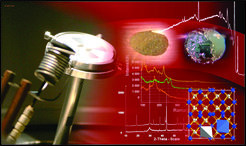
Overview
Vapor deposition techniques (PVD) permit the fabrication of a vast array of materials with high purity, and the ratio of the components can be readily controlled by adjusting the flux of the evaporation sources. In the department Mannhart oxides with special transport or magnetic properties and oxide heterostructures are synthesized with particular emphasis on the pulsed laser deposition (PLD) technique.
For the systematic preparation of solids, two modified approaches are employed: direct synthesis from the elements and evaporation of compounds or mixtures. In particular, investigations are conducted to study the solid state reactions in situ by depositing the components onto a substrate at very low temperatures. In addition to the evolution of crystal structure formation, the physical properties (electrical/optical) of the products are studied in detail. With variation of the experimental parameters, systematic routes for the preparation of desired compounds are explored.
Setup
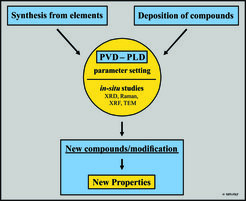
For the preparation process, several ultra-high vacuum (UHV) chambers are available with a special shuttle system, which allows the transfer of samples while maintaining the vacuum and low temperature conditions. The synthesis chamber contains effusion cells, an electron-beam evaporator, and an electron cyclotron resonance (ECR) plasma source for the activation of gases. One of the other deposition chambers is combined with a femtosecond pulse laser deposition system (femto-PLD).
The samples are investigated in situ on an X-ray diffractometer as a function of temperature. The diffractometer is equipped with detectors for X-ray diffraction (XRD) and fluorescence (XRF) analyses in combination with a Raman spectrometer. In situ transmission electron microscopy (TEM) investigations are performed using a special cryo-vacuum holder that can be directly adapted to our deposition chamber.
Metal oxides: ZnO
The presence of superoxide ions (O2-) and related dioxygen species in zinc oxide
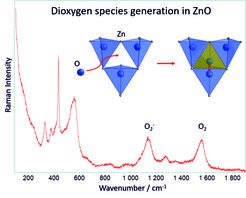
Zinc oxide exhibits unique properties that are evident in a wide range of applications, including as a transparent conducting oxide, a wide-bandgap semiconductor, and a piezoelectric device. To comprehend the origin of these properties, it is essential to understand the subtle details of the crystal structure of ZnO. Consequently, elucidating the formation process of ZnO is crucial.
Our systematic investigation of nanocrystalline ZnO films as a function of deposition temperature has revealed structural disorders caused by the occupation of neighboring, face-connected oxygen tetrahedra, which results in the formation of dioxygen species in zinc oxide. In situ Raman investigations have proven the existence of superoxide ions, O2-, in zinc oxide, which are responsible for the yellow color and have also been detected in ZnO powder and single crystals. Furthermore, additional dioxygen species were identified in the samples, including the O2 molecule (Figure 1). The negative charge excess caused by the dioxygen species results in the formation of metallic zinc as a byproduct for films deposited at room temperature. Moreover, the structural analysis revealed an unforced realization of the dioxygen species within the ZnO lattice.
The wide variety of properties exhibited by ZnO is enabled by the high flexibility of the wurtzite structure, which tolerates significant distance variations. This observation and the results presented provide important insights into the behavior of zinc oxide.
Dieter Fischer, Dejan Zagorac, J. Christian Schön
Journal of Raman Spectroscopy 53 (2022) 12 and Thin Solid Films 782 (2023) 140017.
Further studied oxide films: Tuning TiO2 films / D. Fischer, Thin Solid Films 598 (2016) 204-213.
Polymers: Poly(ethylene oxide) = H-(O-C2H4)n-OH
Deposition of poly(ethylene oxide) films using femtosecond pulsed laser deposition
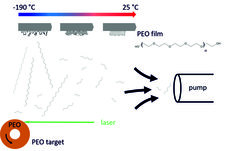
Poly(ethylene oxide), PEO, is a water-soluble, linear polymer with a high quantity of available molecular weights and is utilized in numerous applications in daily life. Coatings and films are of particular importance in these applications.
In this study, PEO films with average molecular weights of 1500, 2000, 4000, 20,000, and 200,000 g/mol were deposited by femtosecond pulsed laser deposition on substrates held at 25 and -190 °C. During the laser ablation process, intact polymer molecules are ejected, as well as fragments consisting of a few monomer groups formed by the degradation of the polymer. The small fragments do not adhere to the substrate (Figure 2).
At room temperature, polycrystalline PEO films are formed with properties that coincide well with the properties of the precursor materials including the films of PEO-200,000, which contain chain lengths of approximately 1 μm. The deposition of PEO polymers at a temperature of −190°C impedes the ordering in the films, resulting in the formation of X-ray amorphous films for both PEO-20,000 and PEO-200,000. Upon warming to room temperature, the films undergo crystallization, assuming the expected configuration.
The analysis of the ejected molecules during the ablation process demonstrates the favorable light matter interaction of the ultrashort laser pulses. The results demonstrate the high potential of femtosecond pulsed laser deposition as an effective and straightforward method for the fabrication of intact polymer films.
Dieter Fischer
Polymer Crystallization 3 (2020) e10153
Elements: Gallium Allotropes
Systematics of the allotrope formation in elemental gallium films
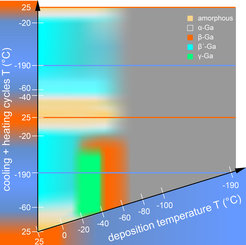
Elemental gallium forms a variety of allotropes, exhibiting distinct structural characteristics that diverge from the close-packing of spheres observed in nearly all elemental metals. At standard pressure, four distinct crystalline allotropes have been identified, with the α-Ga allotrope exhibiting the highest thermodynamic stability. However, the structural relations among the gallium allotropes remain uncertain, as the other allotropes can only be obtained under special conditions, such as spatial confinement or undercooling.
A systematic investigation was conducted to examine the dependence of the crystal structure formation in elemental gallium films on the deposition temperature and the subsequent annealing procedures. The films were prepared using the femtosecond pulsed laser deposition technique on a substrate maintained at a constant temperature within the range of -190 °C to 25 °C. Following deposition, the substrate was subjected to cooling and heating cycles within the aforementioned temperature range.
It was demonstrated that amorphous gallium was formed at room temperature and that the α-Ga allotrope was only formed below -60 °C in the deposited films (Figure 3). However, the most surprising discovery was the identification and characterization of the β'-Ga allotrope from the X-ray powder patterns. It forms a distorted derivative of the β-Ga crystal structure starting from amorphous deposits between 25 and –60 °C. The existence of this new allotrope was also supported by ab initio calculations of the equations of state of the various Ga-allotropes, which revealed nearly identical energies for α-Ga, β-Ga, and β'-Ga.
D. Fischer, B. Andriyevsky, J.C. Schön
Mater. Res. Express 6 (2019) 116401
Metal-Organic Frameworks (MOF): ZIF-8
Deposition of porous MOF thin films (ZIF-8) by femtosecond pulsed-laser deposition (femto-PLD)
D. Fischer, A. von Mankowski, A. Ranft, S.K. Vasa, R. Linser, J. Mannhart, B. V. Lotsch
Chem. Mater. 29 (2017) 5148−5155.




